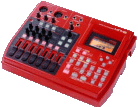Fostex MR-8 and Linux

Introduction:
The user's manual for the Fostex MR-8 claims that the Compact Flash card and the unit itself only work with MS Windows software. However, if you have a working USB Compact Flash card reader set up on your Linux installation you can access the Compact Flash card and the MR-8 unit with relative ease.
Compact Flash:
From the point of view of a computer, the Compact Flash card is nothing more than a VFAT file system. With Linux you can access the card by getting a USB flash card reader and setting up the kernel modules to access it.
If you are lucky, your installation may have been setup to mount your Compact Flash automatically; in fact, the Compact Flash will be mounted when you plug it into the reader and unmounted when you remove it! If you are not so lucky you will have to do a little work to get access to the flash card. I've had the most luck using the 2.6 Linux kernel. With the 2.4 kernel it's been more of a crap shoot.
First you have to verify that you have all the necessary drivers either compiled into the kernel or available as modules. The following modules are necessary to access the device:
nls_iso8859-1
nls_cp437
vfat
fat
usb-storage
uhci
usbcore
sd_mod
scsi_mod
You could throw in the modules to handle hot plug devices and automount the thing, but let's not get carried away. To see if the modules are available on your machine issue the following command for each module in the list above. Be sure to add “.o” to the end of each module:
find /lib/modules/`uname -r`/ -name nls_cp437.o
If the module is available find will print out its exact location; if not it will do nothing. Any modules that are missing will have to be compiled and installed. If these drivers are in the kernel you will just have to try mounting the flash card or recompile the kernel to make sure.
I was able to mount the Compact Flash card as a VFAT file system on one of the /dev/sda (SCSI) devices—mine sets up as /dev/sda1.
Next, as root, create a mount point for the flash card and try to mount it:
su mkdir /mnt/flash mount -t vfat /dev/sda1 /mnt/flash
You can then do “ls -l /mnt/flash” and see what's on it just as you would for any other file system. Later you can tweek the setup so ordinary mortals can access the flash reader and card.
Using the Compact Flash Information:
One of the top reasons for buying the Fostex MR-8 is that it stores songs in WAV file format rather than a proprietary format. With a proprietary format any utilities for dealing with the files would require software from the manufacturer, and that software would probable only run on . . . you guessed it: Windows, and maybe Apple. Linux? Forget it.
With Linux you can copy stuff to and from the card, delete stuff from the card—and completely screw up your favorite song if you are not careful—because the Compact Flash has a VFAT file system and the songs are in WAV files. See the MR-8 User Manual for information on how files are stored on the card.
Software Update for the MR-8:
The software on the MR-8 can be updated using Linux. Go to the Fostex site and get the update zip file and the instructions. Ignore most of the instructions about hooking up the MR-8 directly to your computer and the Windows specific stuff.
On your computer use unzip to decompress the software zip file and copy it to the Compact Flash's root directory. Now, umount the flash card and put it in your MR-8, which, I hope, you turned off to start with! Turn on the MR-8 while holding down the STOP key; the unit will see the update file and ask if you want to update the software to the new version. Respond with yes. When the unit finishes loading the new software simply turns the MR-8 off and then on again.
Accessing the MR-8:
This part is still to be done. I haven't tried to access the unit with Linux, yet. The User Manual describes the MR-8 in such a way to make me believe that it will appear as nothing more than a VFAT file system. I'll have to get a cable and try it. Of course, try it yourself. If I'm wrong there's no harm done by hooking it up.